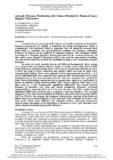JavaScript is disabled for your browser. Some features of this site may not work without it.
| dc.contributor.author | Terry, Leon A. | |
| dc.contributor.author | Landahl, Sandra | |
| dc.date.accessioned | 2020-02-28T09:50:15Z | |
| dc.date.available | 2020-02-28T09:50:15Z | |
| dc.date.issued | 2012-04-01 | |
| dc.identifier.citation | Landahl S, Terry LA. (2012) Avocado firmness monitoring with values obtained by means of laser doppler vibrometry. In: 4th International Conference Postharvest Unlimited 2011, 22-26 May 2011, Leavenworth, Washington, USA | en_UK |
| dc.identifier.issn | 0567-7572 | |
| dc.identifier.uri | https://doi.org/10.17660/ActaHortic.2012.945.32 | |
| dc.identifier.uri | http://dspace.lib.cranfield.ac.uk/handle/1826/15197 | |
| dc.description.abstract | Avocado (Persea americana Mill.) ripeness is usually evaluated by destructive firmness assessment, yet quality is notorious for being heterogeneous within a consignment. This problem, which is especially true for imported avocado fruit, lends itself to searching for non-destructive methods for firmness evaluation. Firmness of objects can be analysed by impulse-response. This technique utilizes recording of a vibration signature and interpretation of the resonant frequency. In this study a laser Doppler vibrometer (LDV) was used for non-contact recording. The aim of this study was to show the feasibility of using a LDV to monitor avocado firmness. In order to create avocado batches of different homogeneity, three groups were treated with and without ethylene, inside or outside a box. After day 0 a third of the fruit were transferred into boxes (325 L) to be treated with ethylene for 24 h. A third was kept in boxes untreated and another third was kept on open trays. Avocado fruit cultivar ‘Hass’ were ripened at 18°C and measured on days 0, 2, 3, 4 and 6. Individual fruit were impacted once and two LDV measurements were taken simultaneously at the stem-end and seed-end. This was repeated twice around the fruit. Force-deformation measurements in compression mode were performed by means of uniaxial testing (Instron model 5542) on two opposite sides (day 0 n=8, then n=24 i.e., 8 per treatment/d). Significant differences were found between firmness of avocados over time and across treatments. Firmness decreased exponentially as expected (304.1 to 2.1 N) over six days. The LDV results showed significant differences between days, treatments and laser-location. The resonant frequency of the fruit decreased linearly until day 4 and then decreased more slowly (1671 to 476 Hz). On average, the frequency found at the seed-end of the fruit was higher than the resonant frequency at the stem-end. This is thought to be due to the seed itself, which could influence the vibration pattern. Resonant frequencies showed good correlation to the logarithm of firmness (r=0.87) and therefore were shown capable of monitoring avocado firmness. | en_UK |
| dc.language.iso | en | en_UK |
| dc.publisher | International Society for Horticultural Science | en_UK |
| dc.rights | Attribution-NonCommercial 4.0 International | * |
| dc.rights.uri | http://creativecommons.org/licenses/by-nc/4.0/ | * |
| dc.subject | Persea americana 'Hass' | en_UK |
| dc.subject | resonant frequency | en_UK |
| dc.subject | non-destructive | en_UK |
| dc.subject | ripeness | en_UK |
| dc.title | Avocado firmness monitoring with values obtained by means of laser doppler vibrometry | en_UK |
| dc.type | Conference paper | en_UK |
Files in this item
The following license files are associated with this item:
This item appears in the following Collection(s)
-
Staff publications (SWEE) [2825]

